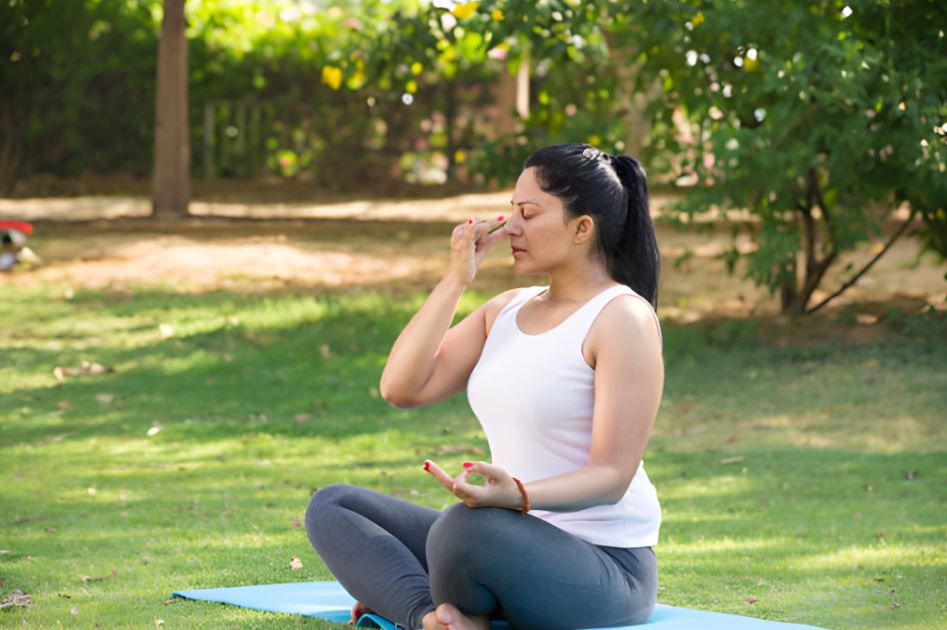Pranayama is one of the most powerful aspects of yoga. It teaches us to control the breath and, through it, the mind and energy. Among the many breathing practices in yoga, Surya Bhedana Pranayama holds a special place because it activates the Pingala Nadi — the solar channel of energy that brings heat, strength, and vitality.
In Sanskrit, Surya means sun, Bhedana means to pierce or to channel through. Therefore, Surya Bhedana literally means “piercing the solar channel”. It is also known as Right Nostril Breathing, because the inhalation is done through the right nostril, which corresponds to the solar or active energy in the body.
This ancient yogic practice is deeply rejuvenating and helps awaken the inner fire — the Agni — responsible for digestion, metabolism, and energy transformation. However, like all pranayama techniques, it should be practiced with awareness and understanding of its effects and limitations.
What is Surya Bhedana Pranayama?
Surya Bhedana Pranayama is a single-nostril breathing technique that focuses on breathing in through the right nostril (Pingala Nadi) and breathing out through the left nostril (Ida Nadi). The right nostril is linked to the sympathetic nervous system, which governs alertness, activity, and physical energy.
When we practice this pranayama, we intentionally stimulate the body’s warming and activating energy, promoting alertness, focus, and vitality. It is especially helpful in colder climates or for people who tend to feel lethargic, low in energy, or mentally dull.
In yogic philosophy, the body’s energy channels, or nadis, are the pathways through which prana (life force) flows. Among the 72,000 nadis mentioned in yogic texts, Pingala represents the solar, masculine, and dynamic energy, while Ida represents the lunar, feminine, and cooling energy. Surya Bhedana balances these by strengthening Pingala and stimulating inner heat.
How to Practice Surya Bhedana Pranayama
Before exploring its benefits, it is important to understand the correct method of practice. Performing this pranayama properly ensures maximum benefit and avoids unnecessary strain.
Step-by-Step Technique
- Find a comfortable posture:
Sit in a meditative pose such as Padmasana (Lotus Pose), Sukhasana (Easy Pose), or Vajrasana (Thunderbolt Pose). Keep your back straight and shoulders relaxed. - Relax and prepare:
Close your eyes and take a few deep, slow breaths to settle your mind and body. Keep your spine upright and head aligned with the neck. - Use Vishnu Mudra:
Use your right hand to control your nostrils. Fold the index and middle fingers inward (toward the palm), leaving the thumb, ring finger, and little finger free. - Close the left nostril:
Gently press your left nostril with the ring finger to close it. - Inhale through the right nostril:
Slowly inhale through the right nostril, feeling the warm, active energy entering your body. The breath should be smooth and deep. - Retain the breath (optional):
If you are an intermediate or advanced practitioner, retain the breath (Kumbhaka) for a few seconds, keeping your focus at the navel center or solar plexus. - Exhale through the left nostril:
Release the left nostril and exhale slowly, letting go of the breath gently. - Repeat the cycle:
This completes one round. Start again by closing the left nostril and inhaling through the right. Repeat 5–10 rounds in the beginning, gradually increasing the duration and number of rounds.
Breathing Ratio (for Intermediate Practitioners)
A common breathing ratio used in pranayama practice is 1:4:2 — inhale, retain, exhale.
For example:
- Inhale for 4 seconds through the right nostril.
- Hold the breath for 16 seconds (if comfortable).
- Exhale for 8 seconds through the left nostril.
Beginners should skip the retention step initially and practice only inhalation and exhalation until they develop control and capacity.
Best Time to Practice
- Morning time is ideal, especially before breakfast, when the stomach is empty and the mind is calm.
- It can also be done during cold weather to generate warmth.
- Avoid practicing in the afternoon heat or immediately after meals.
Physiological Effects of Surya Bhedana
From a scientific perspective, Surya Bhedana activates the sympathetic nervous system, which increases heart rate, blood circulation, and body temperature. It also enhances oxygen intake and stimulates the brain’s alert centers.
From a yogic viewpoint, it activates the Pingala Nadi, responsible for action, energy, and transformation. When practiced regularly, this pranayama balances the physical and mental energy levels, making one more alert, confident, and dynamic.
Surya Bhedana Pranayama Benefits
Surya Bhedana Pranayama offers a wide range of benefits — physical, mental, and energetic. Below are its major advantages explained in detail.
1. Stimulates Digestive Fire (Agni)
This pranayama awakens the body’s internal fire, known as Agni, which plays a vital role in digestion and metabolism. It helps improve appetite, reduces indigestion, and clears sluggish digestion. People who often feel bloated or experience poor digestion may find this practice especially useful.
2. Warms the Body
Since Surya Bhedana is a heating pranayama, it is particularly beneficial during cold seasons. It generates internal heat, removes cold sensations, and helps those who frequently suffer from cold extremities or low body temperature.
3. Enhances Energy and Vitality
By stimulating the solar energy channel, it revitalizes the body and mind. Regular practice increases physical stamina, alertness, and confidence. It helps combat laziness, fatigue, and low mood, leaving the practitioner feeling energized and active.
4. Clears Nasal Congestion and Improves Respiration
The rhythmic breathing process opens the nasal passages, clears mucus, and strengthens the respiratory system. It improves lung capacity and oxygen exchange, benefiting people with mild respiratory issues.
5. Sharpens Focus and Concentration
Surya Bhedana energizes the right brain hemisphere, which is linked with logical thinking and alertness. Practicing this pranayama before work or study can boost mental clarity, focus, and decision-making.
6. Improves Circulation
The deep and controlled breathing enhances oxygen supply to cells, promoting better blood circulation. This helps in detoxification and maintaining overall body vitality.
7. Balances the Nervous System
Though it activates the sympathetic nervous system, regular and balanced practice also improves nervous system regulation, helping one adapt better to stress and external stimuli.
8. Awakens Solar Energy (Pingala Nadi)
In yogic science, this pranayama is considered a way to awaken and purify the Pingala Nadi, the solar channel responsible for dynamism, strength, and willpower. Awakening this energy brings courage, motivation, and vitality to the practitioner.
9. Helps with Low Blood Pressure and Hypothermia
Since this practice raises body heat and improves blood flow, it can be beneficial for people suffering from low blood pressure or feeling constantly cold. It enhances warmth and stabilizes energy levels.
10. Increases Alertness and Activity
Surya Bhedana helps overcome mental dullness, lethargy, or depression. It is a great practice before starting the day’s work, exercise, or any activity requiring energy and focus.
11. Helps Remove Toxins
The increased oxygen flow and body heat produced during practice assist in eliminating toxins through sweat and respiration. It supports a natural detoxification process.
12. Strengthens the Heart and Lungs
The controlled breathing tones the cardiovascular and respiratory systems, making the heart more efficient and lungs stronger. This enhances endurance and stamina.
Surya Bhedana for Mental Well-Being
On a psychological level, Surya Bhedana Pranayama acts as a natural energizer. It helps lift mood and dispel feelings of tiredness or mental fog. Practicing it regularly cultivates a sense of inner strength, confidence, and clarity.
Because it stimulates the sympathetic system, it is particularly useful for people prone to low motivation or depression. However, those who already experience anxiety or restlessness should practice it cautiously, as too much heat or stimulation can increase such symptoms.
Surya Bhedana and Chakra Activation
According to yogic tradition, this pranayama stimulates the Manipura Chakra — the solar plexus chakra located around the navel area. This energy center governs self-confidence, power, and transformation. When activated, it enhances willpower, determination, and the ability to take action.
By focusing awareness on the navel region during breath retention, practitioners can harness this solar energy to cultivate mental strength and purpose.
Contraindications and Precautions
While Surya Bhedana Pranayama offers numerous benefits, it is not suitable for everyone. It is a heating practice and should be approached carefully by those with certain health conditions.
1. High Blood Pressure (Hypertension)
This pranayama increases heat and activates the sympathetic nervous system, which can raise blood pressure. People with hypertension should avoid or modify this practice.
2. Heart Diseases
Those with heart problems should not perform this pranayama without the supervision of a qualified yoga therapist or teacher.
3. Anxiety or Insomnia
Since Surya Bhedana is stimulating, it may aggravate anxiety or restlessness in sensitive individuals. If you experience anxiety, insomnia, or panic attacks, avoid this practice and try Chandra Bhedana (left nostril breathing) instead, which has a cooling effect.
4. Fever or Inflammation
Practicing Surya Bhedana when you have a fever or inflammation may worsen symptoms because it increases internal heat.
5. During Summer or Hot Weather
Avoid practicing during hot weather, as it can lead to excessive heat, dizziness, or dehydration.
6. Pregnancy
Pregnant women should not practice Surya Bhedana or any heat-generating pranayama without medical and expert approval.
7. Gastric or Acid Reflux Problems
Those prone to acidity or heartburn should avoid overdoing this practice, as it can aggravate Pitta dosha (heat element) in the body.
Important Practice Tips
- Always practice on an empty stomach.
- Begin with 5 rounds and gradually increase as comfort improves.
- Maintain gentle, steady breathing — never force the breath.
- If you feel dizzy, restless, or too warm, stop immediately.
- Practice in a calm, well-ventilated place.
- Combine with cooling pranayamas like Sheetali or Chandra Bhedana to balance heat.
Combining Surya Bhedana with Yoga Asanas
This pranayama can be practiced after dynamic asanas like Surya Namaskar, Warrior Pose (Virabhadrasana), or Plank Pose, which also activate solar energy.
It is also an excellent preparation for meditation or mental work, as it clears sluggishness and enhances focus.
Surya Bhedana Pranayama is a powerful breathing practice that ignites the body’s inner fire and awakens the solar energy within. It strengthens digestion, increases vitality, clears mental dullness, and improves focus. However, it must be practiced with awareness, especially for those with heat-related conditions, anxiety, or high blood pressure.
When performed correctly, it not only warms the physical body but also empowers the spirit, giving a sense of strength, motivation, and dynamic energy to face life with confidence.



